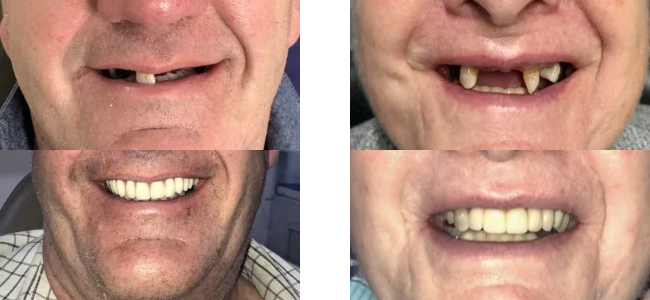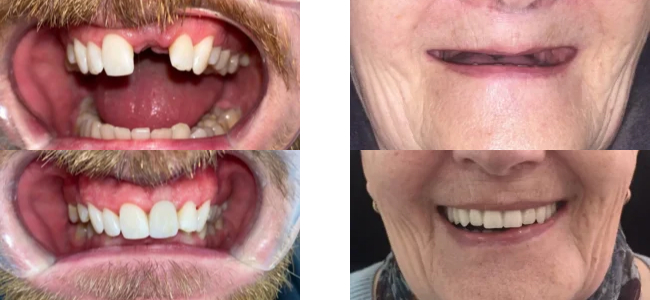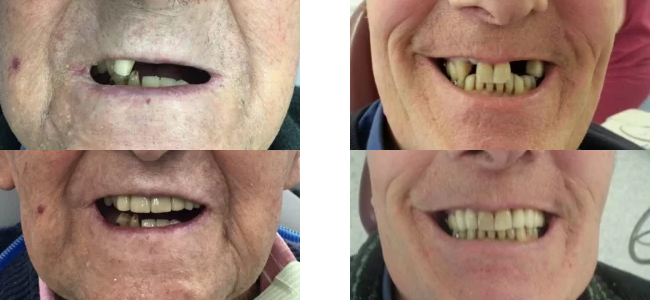After discussing all your options and we feel dental implants would be beneficial. You can then begin your Implant journey.
Implants are placed under local anaesthetic. Sometimes to further stabalise the implants, a bone graft is used around the implant (this can be of animal origin). However, this will only be apparent during the time of surgery.

After your consultation we will provide you with a treatment plan for your proposed treatment. Included in your treatment plan will be the total costs and breakdown. We offer different payment plans which can be discussed with our Treatment Coordinator prior to starting your treatment.
Before you are accepted for implant treatment. You will need to demonstrate and maintain high level of plaque control and oral hygiene. There should be no medical conditions that would contraindicate the procedure. It is important to inform the dentist of any changes to your general health or medical condition.
You should take as much time as you wish to make the decision in relation to signing the consent forms and deciding to go ahead with treatment. Although there is a large amount of information contained in our consent forms. It is important that you understand and read it carefully.
During the course of the implant treatment it is important that you keep the dentist informed of any changes to your general medical condition and of any other additional treatment you may be receiving from a doctor or dentist. Failure to keep the dentist informed may adversely affect or delay your treatment.
It is also important that you keep your appointments and do not miss any stages, as this could adversely affect treatment and delay placement of the new teeth. If an appointment is missed or cancelled with less than 48 hours notice an additional fee will be charged.

*This is an estimated appointment jounery and further appointments maybe needed.
Appointment 1
Information collection 1: Photographs, impressions, diagnostic transfers
Appointment 2
(1 week later)
Information collection 2: Verification of diagnostic information
Appointment3
(1 week after appointment 2)
Placement and fit of implants and fixed temporary. A suitable temporary will be provided.
Appointment 4
(2 weeks after appointment 3)
Review of teeth
Appointment 5
(12 weeks after appointment 4)
Definitive impressions and diagnostics for final teeth.
Appointment 6
(2-3 weeks after appointment 5)
Fit of final Teeth.
The Condition
The condition of the jaws will be assessed for suitability. The treatment will be planned using X-ray films, photographs and models of the teeth. It may be necessary to take a Jaw Scan (CT) type X-ray to check the amount and position of the available bone. The final decision whether or not to proceed with implant placement will be made at the time of surgery. This will be determined by the quality and quantity of the bone within the jaw.
Nerves
An important nerve runs in the lower jaw that supplies sensation to the lower lip and skin of the chin. Obviously the X-ray or CT scan is important in determining the position of this nerve avoiding the slight possibility of injury. Which could result in altered sensation when placing implants in the lower jaw.
Sinus
In the upper jaw it is important to ascertain the size and position of the air sinuses and nasal cavities prior to implant insertion. Occasionally the implants may have to be placed slightly into the sinus or nasal cavity. Usually this is not noticeable but there may be a slight nasal discharge with a small amount of temporary bleeding. In rare situations the implant may fall into these cavities and have to be removed.
Existing Teeth
If the implants are being placed between existing teeth. Then there is always the slight risk that the tooth, its roots or supporting bone may be damaged during the placement procedure. This is more likely to occur if the teeth are very close together or their roots badly angled. As this reduces the amount of space required to accommodate the implant. If this is the case it will have been identified during your assessment and discussed with you prior to implant treatment. Occasionally the teeth either side of an implant may feel slightly different or have an altered sensation.

Implant treatment may entail a combination of the above insertion types. The time required to place them will depend on the number being inserted and their position in the mouth. Every effort will be made to keep the time to a minimum whilst not jeopardising the final result.
The upper jaw is prepared for the implants by making a hole in the bone. This is done by either drilling to cut a channel or by forming the channel using small punches, which are tapped through the bone. The latter may entail the use of a small mallet, which can potentially cause symptoms of nausea or imbalance following the procedure. These symptoms do not persist and subside after several weeks or in rare cases a few months. Which technique is used depends on the density of the bone being prepared and occasionally may entail a combination of the two techniques. The lower jaw is prepared using drilling only.
Back to BlogWe are proud to help our valued patients to transform their smiles through a wide choice of general and cosmetic dental treatments.
Our TreatmentsWe ensure an exceptional patient journey – from start to finish.
learn moreDelivering life-changing smiles and ensuring excellent dental health.
learn moreDental implants and us – together we can recreate a naturally beautiful smile.
learn more